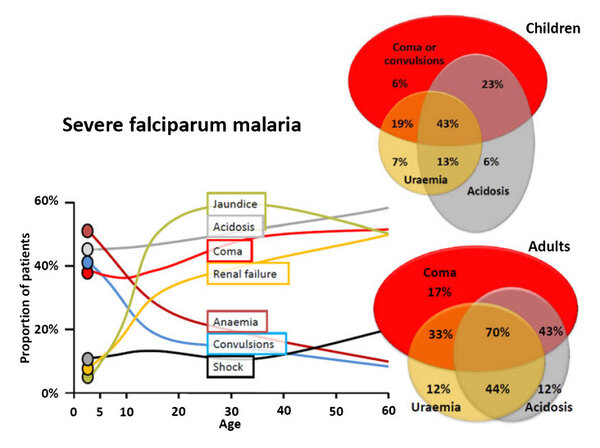Severe Malaria Signs and Symptoms
Clinical symptoms
- Duration of illness (adults: 5–7 days; children: 1–2 days)
- Respiratory distress/ deep breathing (acidosis) (common)
- Convulsions (common)
- Posturing (decorticate/decerebrate and opisthotonic rigidity) (common in children)
- Prostration/obtundation (common)
- Resolution of coma (adults: 2–4 days; children: 1–2 days)
- Neurological sequelae after cerebral malaria (common in children)
- Jaundice (common in adults)
- Hypoglycaemia (common in children)
- Metabolic acidosis (common)
- Renal failure (common in adults)
- CSF opening pressure (Adults: usually normal; Children: usually raised)
- Bleeding/clotting disturbances (up to 10% in adults)
- Rare Invasive bacterial infection as co-infection (common in children)
- Pulmonary oedema (uncommon)
Laboratory Symptoms
- Severe anaemia (haemoglobin < 5g/dl, packed cell volume < 15% in children; <7g/dl, packed cell volume < 20% in adults)
- Hypoglycaemia (< 2.2mmol/l or < 40mg/dl)
- Acidosis (plasma bicarbonate < 15mmol/l)
- Hyperlactataemia (lactate > 5mmol/l)
- Renal Impairment (serum creatinine > 265μmol/l)
- Hyperparasitaemia*
*High parasitaemia is undoubtedly a risk factor for death from P. falciparum malaria, but the relation between parasitaemia and prognosis varies according to the level of malaria transmission.
Severe P. falciparum related to symptoms
Using data compiled from prospective series of severe P. falciparum malaria studies, a TMIH supplement on severe malaria shows the prevalence of different features of severe P. falciparum malaria by age on the left side, and the mortality in children and adults associated with manifestations of cerebral and renal impairment and metabolic acidosis alone or in combination using Venn diagrams on the right side. The sizes of the ovals are proportional to number of cases.
